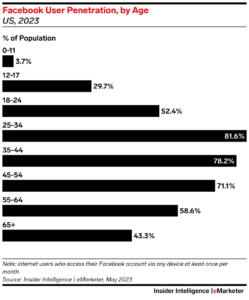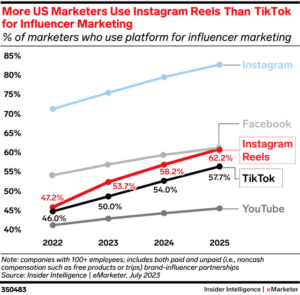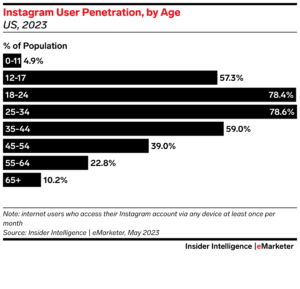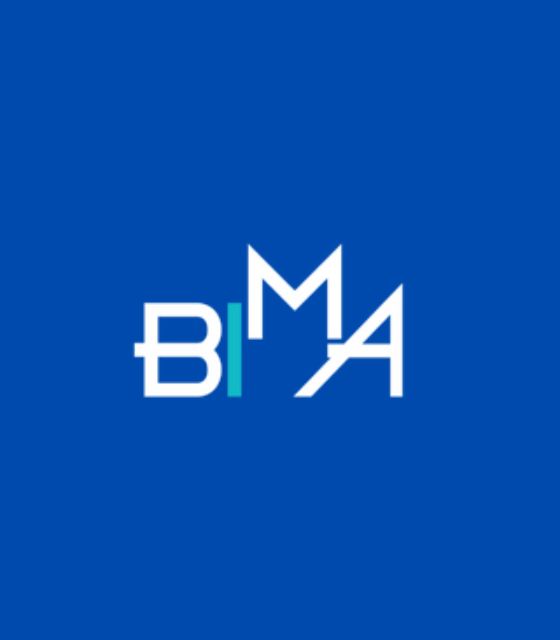Analysts predict that Facebook and Instagram will continue to earn higher revenue than its competition in the coming year, with Facebook bringing in $1.02 per user, per hour by 2025.
The platforms’ predicted growth is in large part because Meta has the favor of marketers worldwide due to its ease of use and wide range of tools. It also has a higher potential for ad revenue than competitors.
According to eMarketer analyst Debra Aho Williamson, the reason for this competitive edge comes down to user preference; advertisers continue to have a strong preference for Meta. In her podcast Behind the Numbers, she explains that advertisers want a consistent and dependable platform for advertising, and therefore Meta will continue to receive the majority of advertising dollars.
Despite TikTok‘s increasing popularity among users, Meta’s operational capabilities and advertising products continue to attract and retain marketers on their platform, building ongoing loyalty among advertisers.
While TikTok has the potential to become a more traditional social network, as Williamson discusses in The Daily, it remains a less familiar, and less profitable platform for advertisers.
This preference makes it clear that, among advertisers, Meta products like Facebook and Instagram are here to stay.
So, what are the differences between Meta’s two biggest social platforms – why choose one network over the other? And when using both platforms, how can marketers tailor their content to the best target audiences?
Facebook is one of the oldest major social media networks and Meta’s founding social site. Not only is Facebook a classic, but it is continuing to grow.
In Q3 2023, both Facebook’s monthly and daily active users grew, with daily active users growing to 2.09 billion up by 5% year over year.
Benefits
Facebook has many benefits for advertisers. In addition to giving marketers access to a large and diverse audience, Facebook’s ads manager functions almost as its own DSP, allowing marketers to purchase programmatic ads directly on Facebook itself.
This is just one way Facebook makes advertising accessible and easy to use.
Another key benefit of Facebook is familiarity. Facebook is familiar territory for both advertisers and users, making it easy to integrate into existing and new marketing campaigns.
Key demographics
Facebook is popular globally, making it relatively easy to target demographics from around the world. The most frequent users of Facebook are, however, aging, with the core demographics of the platform being slightly older than other sites (like Instagram). Most Facebook users fall between the ages of 25 and 55.

Instagram was launched in 2010 as the ultimate photo-sharing site. Since then the social media platform has grown to become so much more than a picture board – with the addition of Stories and Reels.
Instagram has seen steady growth since its launch and has continued to gain popularity with both users and advertisers as it adjusts its platform to fit the evolving needs of its user base.
Benefits
Instagram has many competitors in both the photo-sharing space and the short-form video space. What Instagram has that TikTok lacks, is advertiser loyalty. This is in large part because, like Facebook, its advertising platform is more familiar and therefore easier to use. Instagram is also a familiar platform to users, who continue to use the platform years after signing up.

In addition to being easy to navigate, Instagram has ample tools for marketers to be able to post and optimize their social ads.
Key demographics
Like Facebook, Instagram is used worldwide. But, unlike Facebook, Instagram tends to attract a younger demographic. Most regular Instagram users are between the ages of 18 and 34, making it an ideal platform for targeting younger millennials and Generation Z.

While Facebook and Instagram are both excellent options for marketers, they target slightly different age cohorts. This is great because it allows marketers to either select the platform that best suits their audience and focus their efforts there or to tailor their content for each platform, creating a well-rounded, cross-channel approach. This makes it easy to appropriately target specific audiences on Meta, effectively communicating with customers and having the greatest possible impact.

Learn how illumin unlocks the power of journey advertising for Meta
Get started!To see more from illumin, be sure to follow us on Twitter and LinkedIn where we share interesting news and insights from the worlds of ad tech and advertising.











